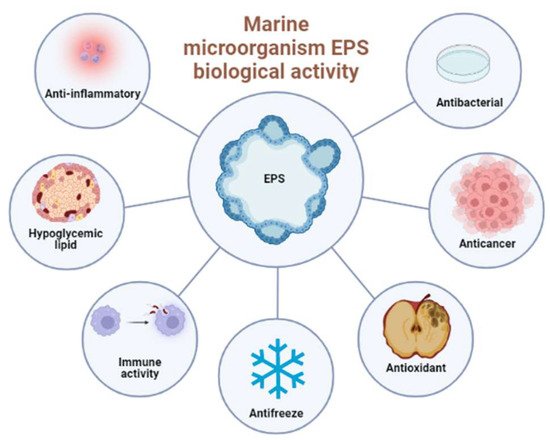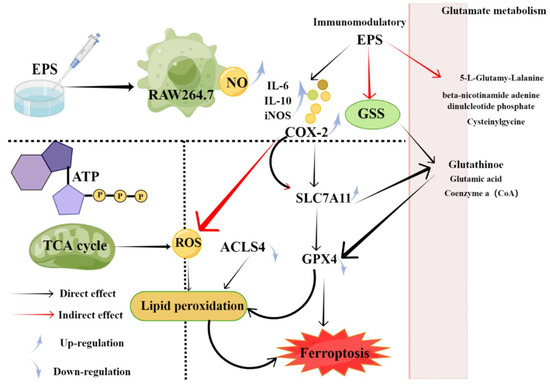Your browser does not fully support modern features. Please upgrade for a smoother experience.
Please note this is a comparison between Version 2 by Peipei Wang and Version 7 by Jessie Wu.
The unique living environment of marine microorganisms endows them with the potential to produce novel compounds with diverse biological activities. Exopolysaccharide (EPS) is a high molecular weight carbohydrate polymer secreted by microorganisms during growth and metabolism. The complex and diverse structures of EPS endow them with unique biological activities and functions.
- exopolysaccharides
- marine
- antioxidant activity
1. Introduction
The structure of the marine microbial Exopolysaccharides (EPS)PS is complex and diverse [1][ 101 ], andwhich is linkrelated to various biological activities, such as antibacterial, antioxidant, anti-cancer, antifreeze, anti-inflammatory, enhancement of ing immune activity and blood pressure, and lipid reductionlowering, etc. [ 102 , 103, 104, 105 ] [2][3][4][5]. _ _ _ _ _ In addition, due to the particularity of the marine microbial environment, the EPS produced by marine microbialoorganisms also have a s potential application value in the marine ecological environment. Here, researcherswe mainly introduced the antioxidant activity, anticancer activity, anti-infectiousn activity, and immune-enhancing biological activity of the marine microbial EPS (as shown in as shown in Figure 1 ) and theirits potential applications in bioremediation and carbon sequestration.

Figure 1. Main biological activities of marine microbial EPS.
2. Antioxidant Activity
2. Antioxidant activity
Oxygen is thea key substance infor the normal life- metabolism of aerobic organisms [6][ 106 ]. In the metabolism of organisms, the living organisms inevitably producgenerate reactive oxygen species (ROS) [ [7]107 ]. High levels of ROS may disrupt the pro-oxidant/antioxidant balance in organisms, leading to oxidative stress [ [8]108 ]; excessive ROS will destroycan disrupt the normal function of lipids, proteins, and DNA in human cells, thusereby inducing various diseases [9][ 109 ] ]. SMultipleveral piec lines of evidence have proveddemonstrate that antioxidants play an important role in protecting humans from cancer, diabetes, cardiovascular disease, and neurodegenerative diseases related toassociated with different types of oxidative damage [10][11][12][ 110 , 111 , 112 ].
EPS from marine bacteria generally has strong antioxidant activity, which is related to the structural features of EPS, including sulfate content and its binding sites, monosaccharide residues, and glycosidic bonds [13].[ Marine13 bacterial]. EPSMarine bacterial EPS often contributes to the formation of biofilms, which adapt to extreme environments, such as high salinity often contributes to the formation of biofilms, which adapt to extreme environments, such as high salinity, low temperature, and high osmotic pressure [14][15][16][ 113,114,115 ] . For example, AEPS of Rhodella reticulata has a stronger scavenging ability for superoxide anion than the standard antioxidant α-tocopherol [17][ 116 ]. EPS sp isolated from Polaris marine arcticum. SM1127 has good antioxidant capacity. The antioxidant capacity is significantly higher than that of hyaluronic acid (HA), a common free radical scavenging binder in cosmetics, which indicates that this EPS has a good application prospect in the field of cosmetic antioxidants in the future [18][ 59 ]. In addition, SM1127 can remove excess reactive oxygen species produced by wound infection and inflammation, thereby accelerating wound healing. Therefore, this EPS is likely to be used to accelerate the healing of frostbite, burns and other wounds [19][ 60 ]. Wu et al. reported that the marine bacterium EPS EPS27 produced by P. stutzeri 273 had a good hydroxyl radical scavenging rate, up to 70% when the EPS concentration was 60 μg/mL. Therefore, EPS27 has good antioxidant activity and has potential applications in food and health care fields [ [20]49 ]. The skin is the largest organ of the human body, and skin wound healing is an important clinical problemproblem [117, 118, 119 ] [21][22][23]. Since synthetic drugs carry a high risk of side effects, such as allergy and drug resistance, natural products such as EPS are becoming increasingly important and are strongly recommended as alternative medicines for wound healing.
Another source of antioxidants is EPS produced by marine fungi. Wang et al. A novel extracellular polysaccharide (YSS), consisting of Man and Gal units with a molecular weight of 18.6 kDa, was discovered from the marine fungus Aspergillus kawachi [24][ 85 ]. YSS has a strong scavenging ability to DPPH free radical with EC50 of 2.8 mg/mL. Chen et al. It has been reported that the marine fungus Fusarium oxysporum produces a novel galactofuranos-containing EPS Fw-1, mainly composed of Gal, Glc and Man, with a molecular weight of 61.2 kDa [25][ 83 ]. The EC50 of Fw-1 for hydroxyl and superoxide radical scavenging was 1.1 and 2.0 mg/mL, respectively, which was greater than that of the EPS A. versicolor LCJ-5-4 named AVP isolated from the ocean ( EC50 of 4.0 mg/mL ). The antioxidant EPS monosaccharide extracted from marine fungi is relatively simple in composition and small in molecular weight, which is more suitable for studying the relationship between marine polysaccharide structure and antioxidants [ [26][27]80 , 120 ].
Epidemiological investigations have demonstrated a strong correlation between antioxidant utilization and reduced risk of common chronic diseases such as cardiovascular disease and cancer. Compared with many reports on the antioxidant activity of marine microbial EPS, there are few reports on the isolation, purification and structural analysis of marine microbial EPS. It is necessary to study their structure-activity relationship in depth.
3. Anticancer Activity
3. Anticancer activity
Now, new sources of nontoxic natural substances with potential anticancer effects are being actively researched [ [28]121 ]. In the past decade, there has been great interest in developing anticancer polysaccharide drugs. Marine microorganisms have unique metabolic and physiological capabilities that enable them to produce various biological compounds [29][30][31][122, 123, 124 ] , such as EPEPS . S. Several marine microbial EPS have been reported to have anticancer activity through mitochondrial dysfunction, inhibition of cell proliferation, or modulation of the immune system [ [32][33][34][35][36][37][38]42 , 58 , 94 , 125 , 126 , 127 , 128 ]. Matsuda et al. investigated marine Pseudomonas polysaccharide B1 and found that it could induce apoptosis in U937 cells [38][ 128 ]. Chen et al. The Antarctic bacterium Pseudoaltermonas sp has been reported . S-5 produces a hetero-exopolysaccharide (called PEP) that significantly inhibits the growth of human leukemia cell K562 [ [33]58 ]. Additionally, Ramamoorthy Sathishkumar et al. Discovery of EPS from ascidian symbiotic Bacillus thuringiensis It has good anticancer activity in vitro. Compared to normal Vero cells, this polysaccharide showed potential cytotoxicity against cancer cell lines A549 and HEP-2. The inhibitory rate of EPS on both cancer cell lines increased in a dose-dependent manner [ [32]42 ]. AS2-1 produced by Alternaria . The growth of Hela, HL-60 and K562 cells can also be inhibited in a concentration-dependent manner [39][ 84 ]. The marine bacterial exopolysaccharide EPS11 can effectively inhibit the adhesion, migration and invasion of hepatoma cells; this potential target protein and molecular mechanism were first explored by targeting the β1-integrin signaling pathway of type I collagen [ 126 [36]] . Recently, a study showed that newly isolated marine bacterial EPS could enhance the antitumor activity of HepG2 cells by affecting key apoptotic factors and activating toll-like receptors (TLRs) [40].[ 129 ]. Other studies have shown that chemical modifications of EPS, such as acetylation, carboxymethylation, and sulfonation, can also enhance its biological activity [ [41][42]130 , 131 ], which in turn enhances its anticancer activity. Maza et al. Two polysaccharides, EPS-DR and EPS-DRS, were demonstrated to form complexes with scandium, and these complexes displayed various biological activities, especially antiproliferative properties in cancer cells.
4. Anti-infectious Disease
4. Anti-infectious disease
EPS also plays an important role in fighting infectious diseases. Numerous studies have shown that the immunological and antiviral activities of marine microbial EPS have potential value in inhibiting certain influenza viruses and bacteria [ [43]132 ]. EPS, as a potent antibacterial agent, mainly inhibits bacterial growth by inhibiting biofilm formation. Mihlid H et al. Enterobacteriaceae are reported . ACD2 EPS from Tabuk region of Saudi Arabia showed some inhibitory effect on Escherichia coli and Staphylococcus aureus [44][ 48 ]. Durairajan Rubini et al. reported a marine polysaccharide with good antibacterial activity and strong inhibitory effect against uropathogenic Escherichia coli (UPEC), providing an antibiotic-free approach for the treatment of urinary tract infections [45][ 133 ]. Similarly, Wu et al. The exopolysaccharide EPS273 from the culture supernatant of the marine bacterium P. stutzeri 273 was reported to inhibit P. aeruginosa via anti-biofilm activity [20][ 49 ]. It is not only effective against animal bacteria but also plant bacteria. Marwa Drira et al. EPS produced by Porphyridium sordidum was found to lead to plant control of fungal growth, and EPS could act as an inducer to enhance the resistance of Arabidopsis to Fusarium oxysporum [46][ 24 ]. In addition, sulfated EPS from Porphyridium sp. Antiviral effects have been shown against herpesviruses (HSV-1 and HSV-2) [47][48][ 134,135 ] .
5. Immunomodulatory Activity
5. Immunomodulatory activity
The main function of the immune system is to recognize and eliminate pathogens to maintain physiological balance and stability [49][ 136 ]. When immunity is compromised, various adverse immune responses result [50].[ Several137 EPSs]. synthesizedSeveral EPSs synthesized by marine microorganisms have immunomodulatory activitiesactivities [ 45, 60, 61, 74, 138, 139, 140 [19][51][52][53][54][55][56]]. For_For example, an EPS called EPS2E1 was extracted from the marine Halomonas sp. And showed good immune-enhancing activity, mainly by activating MAPK and NF-κB pathways [57][ 56 ]. Soumya Chatterjee et al. reported Sphingobacter sp., a new α-mannan EPS from Sphingobacter arcticum. IITKGP-BTPF3 significantly reduced LPS-induced NO production in macrophages. These results suggest that sphingosine has a potential activating effect on the anti-inflammatory effects of macrophages in vitro [58][ 57 ]. On the one hand, there is evidence that marine microbial EPS can induce the expression of cytokines, such as interleukin (IL), tumor necrosis factor (IF-α), and interferon [ [59]141 ]. Additionally, Adriana et al. It has been reported that EPS-1 may help improve immune surveillance of PBMCs against viral infection by inducing polarization in favor of Th1 subsets. Bacillus licheniformisProduced EPS-1 induces cytokine production to enhance immune regulation [54][ 138 ]. It mainly promotes macrophage secretion of mediators and enzymes, such as NO, COX-2, IL-1, IL-6 and TNF-α, which play an important role in mediating inflammation and tissue repair in RAW264.7 macrophages. [60][61][62][63]142, 143, 144, 145 ] . _ _ _ _ _ YCP, a native EPS derived from the mycelium of the marine filamentous fungus Phoma herbarum YS4108 , binds to TLR-2 and TLR-4, and is expressed by T cells and dendritic cells (DC) It has great antitumor potential due to specific immunomodulatory ability mediated. 146 [64]]. Recently, a novel EPS (AUM-1) SCAU-266 was obtained from marine Aureobasidium melanogenum with potential effects on ferroptosis-related immunomodulatory properties in RAW264.7 cells. Mechanistic studies have shown that due to higher levels of reactive oxygen species in glutamate metabolism and TCA cycle, it can regulate the expression of GPX4, regulate glutathione (oxidation), and directly cause lipid peroxidation ( Figure 2 ) [53][ 74 ].

